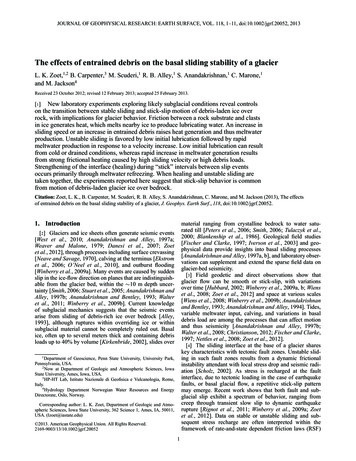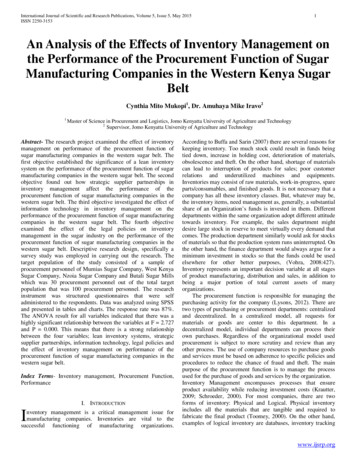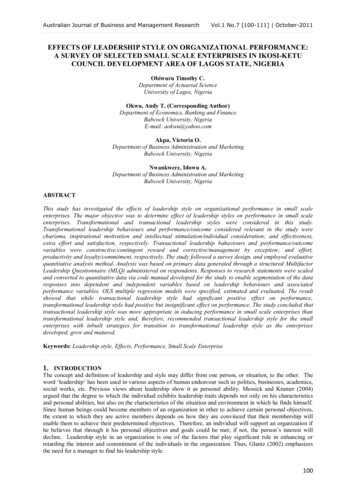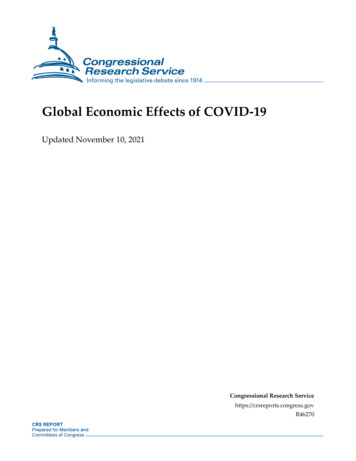
Transcription
Global Economic Effects of COVID-19Updated November 10, 2021Congressional Research Servicehttps://crsreports.congress.govR46270
SUMMARYGlobal Economic Effects of COVID-19The COVID-19 viral pandemic is an unprecedented global phenomenon that is also a highlypersonal experience with wide-ranging effects. On September 20, 2021, U.S. viral deathssurpassed the 675,446 total from the 1918 Spanish flu, the previously worst U.S. pandemicrelated death total on record. The pandemic has disrupted lives across all countries andcommunities and negatively affected global economic growth in 2020 beyond anythingexperienced in nearly a century. Estimates indicate the virus reduced global economic growth in2020 to an annualized rate of around -3.2%, with a recovery of 5.9% projected for 2021. Globaltrade is estimated to have fallen by 5.3% in 2020, but is projected to grow by 8.0% in 2021.According to a consensus of forecasts, the economic downturn in 2020 was not as negative asinitially estimated, due in part to the fiscal and monetary policies governments adopted in 2020.In most countries, economic growth fell sharply in the second quarter of 2020, rebounded quicklyin the third quarter, and has been mostly positive since. Although lessening, the total globaleconomic effects continue to mount. In particular, the prolonged nature of the health crisis isaffecting the global economy beyond traditional measures with potentially long-lasting and farreaching repercussions. Economic forecasts reflect continuing risks to a sustained globalrecovery posed by a resurgence of infectious cases and potential inflationary pressures associatedwith pent-up consumer demand fueled by an increase in personal savings. On the supply side,shortages reflect lingering disruptions to labor markets, production and supply chain bottlenecks,disruptions in global energy markets, and shipping and transportation constraints that are addingto inflationary pressures.R46270November 10, 2021James K. Jackson,CoordinatorSpecialist in InternationalTrade and FinanceMartin A. WeissSpecialist in InternationalTrade and FinanceAndres B. SchwarzenbergAnalyst in InternationalTrade and FinanceRebecca M. NelsonSpecialist in InternationalTrade and FinanceKaren M. SutterSpecialist in Asian Tradeand FinanceAs some developed economies start recovering, central banks and national governments areweighing the impact and timing of tapering off monetary and fiscal support as a result ofconcerns over potential inflationary pressures against the prospect of slowing the pace of theMichael D. Sutherlandrecovery. These concerns are compounded by the emergence of new disease variants and rollingAnalyst in Internationalpandemic hotspots that challenge national efforts to contain infections and fully restore economicTrade and Financeactivities. Major advanced economies, comprising 60% of global economic activity, are projectedto operate below their potential output level through at least 2024, which indicates lower nationaland individual economic welfare relative to pre-pandemic levels. Compared with thesynchronized nature of the global economic slowdown in the first half of 2020, the globaleconomy has shown signs of a two-track recovery that began in the third quarter of 2020 and hasbeen marked by a nascent recovery in developed economies where rates of vaccinations are high, but a slower pace of growthin developing economies where vaccination rates are low.As a whole, developed economies have made strides in vaccinating growing shares of their populations, raising prospects of asustained economic recovery in late 2021 and into 2022 and, in turn, a recovery in the broader global economy. However,new variants of the COVID-19 virus and a surge in diagnosed cases in large developing economies and resistance tovaccinations among some populations in developed economies raise questions about the speed and strength of an economicrecovery over the near term. A resurgence of infectious cases in Europe, Latin America, Russia, the United States, Japan,Brazil, India, and across much of Africa renewed calls for lockdowns and curfews and threatened to weaken or delay apotential sustained economic recovery into late 2021. The economic fallout from the pandemic has had a disparate impact oncertain sectors of the economy, particularly the service sector, and certain population groups and could risk continued labordislocations. In some cases, workers are reconsidering their career choices and work patterns, which may imply postpandemic economies marked by more varied labor arrangements and altered urban environments.The human costs in terms of lives lost will permanently affect global economic growth in addition to the cost of elevatedlevels of poverty, lives upended, careers derailed, and increased social unrest. Some estimates indicate that 65 million to 75million people may have entered into extreme poverty in 2020 with 80 million more undernourished compared to prepandemic levels. In addition, some estimates indicate that the decline in global trade in 2020 exacted an especially heavyeconomic toll on trade-dependent developing and emerging economies. This report provides an overview of the globaleconomic costs to date and the response by governments and international institutions to address these effects.Congressional Research Service
Global Economic Effects of COVID-19ContentsOverview . 1Background . 4Economic Policy Challenges . 5Impact on Workers. 9U.S. Labor Market. 11Financial Markets . 14Economic Policy Responses . 15Industry Measures . 16Fiscal Measures . 17Fiscal Deficits . 18Worker Assistance Programs . 20Monetary and Prudential Measures . 22Economic Forecasts . 26Global Growth. 26The OECD Forecast . 29The IMF Forecast. 36The World Bank Forecast . 38Global Trade . 39Supply Chains . 42Global Foreign Investment . 44Major Economic Developments . 49Financial Markets . 50International Role of the Dollar . 53U.S. Monthly Trade . 57Global Energy Markets . 59Country Policy Responses . 61The United States . 63Monetary Policy . 68Fiscal Policy . 70Personal Income and Outlays. 74GDP Output “Gap” . 76Federal Reserve Forecast . 79Europe . 81The United Kingdom. 91Japan. 95China . 97Multilateral Response . 98International Monetary Fund. 98World Bank and Regional Development Banks . 99International Economic Cooperation . 100Estimated Effects on Other Economies . 102Asian Development Bank 2021 Forecast . 102International Economic Cooperation . 103Looming Debt Crises and Debt Relief Efforts . 104Congressional Research Service
Global Economic Effects of COVID-19Other Affected Sectors . 106Issues for Congress . 108FiguresFigure 1. Composition of Working-Hours Lost by Region, 2020 . 10Figure 2. Weekly Claims for Unemployment Insurance, 2020 and 2021. 13Figure 3. IMF Projected Government Fiscal Deficits Relative to GDP . 19Figure 4. Major Economic Forecasts by Region . 29Figure 5. Unemployment Rates Among Major OECD Countries . 31Figure 6. Projected Time to Full Recovery in Employment in Selected OECD Countries . 32Figure 7. IMF Forecast, Gross Domestic Product . 38Figure 8. WTO Estimates of Quarterly Global Exports and Imports, Volumes and Values . 41Figure 9. Annual Foreign Direct Investment Inflows by Major Country Groups . 47Figure 10. Global Foreign Direct Investment Inflows . 48Figure 11. U.S. Direct Investment; Inflows and Outflows . 49Figure 12. Dow Jones Industrial Average . 52Figure 13. U.S. Dollar Trade-Weighted Broad Index, Goods and Services . 54Figure 14. International Role of the Dollar . 55Figure 15. Quarterly Price and Quantity Indexes, U.S. Goods Imports and Exports . 57Figure 16. Monthly U.S. Exports and Imports of Goods and Services 2020-2021 . 59Figure 17. Brent Crude Oil Price Per Barrel in Dollars. 60Figure 18. U.S. GDP Percentage Change From Preceding Quarter . 65Figure 19. Change in Total Monthly U.S. Nonfarm Employment . 66Figure 20. Change in U.S. Employment by Major Industrial Sector . 67Figure 21. U.S. Personal Income, Consumption, and Saving . 76Figure 22. Real and Potential U.S. GDP and the Output Gap . 78Figure 23. UK Quarter Over Quarter Percentage Change in GDP . 93Figure 24. Asian Development Bank 2020 and 2021 GDP Forecasts . 103TablesTable 1. Change in Gross Domestic Product by Major Country . 6Table 2. Investment Policy Instruments Adopted at the National and International level toAddress the COVID-19 Pandemic . 16Table 3. Elements of Announced Fiscal Measures to Address COVID-19 . 18Table 4. Developed Economy Worker Support Programs During COVID-19 . 21Table 5. Selected Central Bank and Prudential Measures to Address COVID-19 . 24Table 6. Major Economic Forecasts . 27Table 7. OECD, IMF and World Bank Economic Forecasts . 33Table 8. WTO Forecast: Merchandise Trade Volume and Real GDP 2020-2022. 41Table 9. Foreign Investment Screening Legislation Adopted During COVID-19 . 44Congressional Research Service
Global Economic Effects of COVID-19Table 10. Investment Policy Instruments Adopted at the National and International Levelsto Address the COVID-19 Pandemic . 46Table 11. Dow Jones Industrial Average Market Changes by Month. 50Table 12. U.S. Goods and Services Exports and Imports, Change in Quarterly Price andQuantity Indexes . 58Table 13. IMF Forecast of Major Advanced Economy GDP Output Gap . 77Table 14. Congressional Budget Office Projection of Major U.S. Economic Indicators,2021 to 2031 . 78Table 15. Federal Reserve Economic Projections, September 2021 . 80Table 16. EU Real GDP Growth Rates 2020 and 2021 . 83Table 17. European Commission Economic Forecast . 85Table 18. UK Quarterly GDP Aggregates 2019-2021 . 93Table 19. UK Forecast of Major Aggregate National Accounts, 2020-2023 . 94Table 20. Japan Main Economic Accounts, 2020 and 2021 . 96ContactsAuthor Information. 110Congressional Research Service
Global Economic Effects of COVID-19OverviewThe World Health Organization (WHO) first declared COVID-19 a global health emergency inJanuary 2020; on March 11 it announced the viral outbreak was officially a pandemic, the highestlevel of health emergency.1 Since then, the emergency evolved into a global public health andeconomic crisis that affected the 90 trillion global economy beyond anything experienced innearly a century. In a variance of John Donne’s poem, “No Man is an Island,” the viral infectionspread between and across countries and affected nearly every community, demonstrating thehighly interconnected nature of the global economy: the virus has been detected in every countryand all U.S. states.2 The focal point of infections shifted from China to Europe, especially Italy,by early March 2020, but by April, the focus had shifted to the United States, where the numberof infections had been accelerating. By April 2021, India, Brazil, parts of Africa and Asiaemerged as viral hot spots with the number of infections and deaths reaching daily record levels.By mid-September 2021, the more virulent COVID-19 Delta variant reportedly had become themore globally dominant strain of the virus and prompted various national leaders to call foradditional health measures, including reintroducing travel restrictions.3 Projections by theEuropean Center for Prevention and Disease Control (ECDC) indicated the variant could accountfor 90% of coronavirus infections across much of Europe by the end of August 2021 and “couldlead to a fast and significant increase in daily cases in all age groups.”4 The Delta variant was alsogrowing as a share of total cases in the United States, accounting for 97.9% of all cases in lateAugust 2021, according to the Center for Disease Control (CDC).5 After escaping the initialrounds of infections, cases were growing rapidly in Australia and New Zealand, which institutedrestrictions on social gatherings and movement.6 COVID-19 infections were rising in Russia inJune 2021, reportedly due to the unwillingness of the populace to receive the Russian-developedSputnik V vaccine.According to the World Health Organization, by November 1, 2021, the COVID-19 virus hadsickened over 246.6 million people globally with over 5.0 million fatalities:7 the United Statesreported that over 45.6 million Americans had been diagnosed and over 740 thousand people haddied from the virus. At one point, more than 80 countries had closed their borders to arrivals fromcountries with infections, ordered businesses to close, instructed their populations to selfquarantine, and closed schools to an estimated 1.5 billion children.8 On August 23, 2021, theBill Chappell, “COVID-19: COVID-19 Is Now Officially a Pandemic, WHO Says,” National Public Radio, March11, 2020. pandemic-who-says.2 “Mapping the Spread of the COVID-19 in the U.S. and Worldwide,” Washington Post Staff, Washington Post, March4, 2020. pping-spread-new-COVID-19/?arc404 true.3 Ang, Katerina, Delta is By Far World’s Most Dominant Coronavirus Variant, WHO Says, The Washington Post,September 22, 2021; Gross, Anna, Leila Abboud, and John Burn-Murdoch, Delta Variant Begins to Spread,Threatening EU’s Covid Progress, Financial Times, June 21, 2021. 2d3efa2ed52b.4 Miller, Michael E., Covid-19 Updates: Merkel Warns Europe is ‘On Thin Ice’ as Concerns About Delta VariantGrow, The Washington Post, June 25, 2021.5 Center for Disease Control. proportions.6 Pannett, Rachael, Sydney Enters ‘Scariest’ Phase of Pandemic as Delta Variant Spreads, Leader Says, TheWashington Post, June 24, 2021.7 World Health Organization. https://covid19.who.int/.8 “The Day the World Stopped: How Governments Are Still Struggling to Get Ahead of the COVID-19,” TheEconomist, March 17, 2020. /governments-are-still-struggling-to1Congressional Research Service1
Global Economic Effects of COVID-19Food and Drug Administration (FDA) gave full approval to the Pfizer-BioNTech coronavirusvaccine, leading various institutions and the U.S. military to begin mandating vaccinations foremployees and members.9As infectious cases began rising sharply in late February 2020, governments took unprecedentedsteps in March 2020 to lock down social activities to contain the spread of the pandemic,inadvertently creating a global economic recession. Government responses in March 2020 wereextraordinary in terms of the speed with which they took place, the broad scope of the fiscal andmonetary policies they adopted, and the number of countries that were involved, often without aformal, coordinated plan. Initially, governments adopted monetary policies aimed at stabilizingfinancial markets and ensuring the flow of credit. In the second phase, governments focusedpolicy actions on fiscal measures aimed at sustaining economic growth as they adoptedquarantines and social distancing measures. In the third phase, governments shifted policies todeveloping, purchasing and distributing vaccines. As the health and economic effects haveevolved and persisted, the phases of government actions have become less distinct: efforts tovaccinate populations have coincided with additional fiscal measures to sustain householdincome, for instance.The Bureau of Economic Analysis (BEA) reported that policy actions to lock down the economypushed the U.S. GDP growth rate down to 9.0% in the second quarter of 2020 compared with theprevious quarter, or at an annualized rate of -31%, the largest quarterly decline in U.S. GDPrecorded over the past 70 years.10 Subsequently, U.S. GDP grew by 7.5% in the third quarter, or atan annualized rate of 30%, based primarily on gains in personal consumption, reflecting anincrease in income and support through government transfer payments.11 Fourth quarter 2020 dataindicate the U.S. economy grew by slightly more than 1.0% over the third quarter, or at anannualized rate of 4.5%. On a year-over-year basis, U.S. real GDP is estimated to have declinedby 3.4% in 2020 compared with 2019.12 In the third quarter of 2021, the annual rate of growth ofU.S. GDP rose by 2.0%, after rising by 6.3% and 6.7% in the first and second quarters,respectively.In its September 8, 2021, Beige Book analysis, the Federal Reserve (Fed) reported that economicactivity had slowed slightly in the July through August period compared with moderate to robustgrowth in all 12 Federal Reserve Districts during the May to early July period. The Fed attributedthe slowdown in activity to lower levels of consumer dining and recreation activities arising fromconcerns over the spread of infections by the Delta variant of the COVID-19 virus. Other sectorsof the economy experienced slower growth as a result of labor and supply-side shortages. Lowinventory levels in the auto sector and reduced supplies of residential housing also constrainedsales activity in these sectors; the Fed also reported mild gains in residential and nonresidentialconstruction and in the energy and agricultural sectors.13 In its Monetary Policy report onSeptember 22, the Fed indicated the economy had recovered to the point where it could begin aget-ahead-of-the-COVID-19.9 Guarino, Ben, Laurie McGinley and Tyler Pager, Pfizer-BioNTech Coronavirus Vaccine Gets Full FDA Approval,Potentially Persuading the Hesitant to Get a Shot, The Washington Post, August 23, 2021.10 Gross Domestic Product, 2nd Quarter 2020 (Advance Estimate) and Annual Update, Bureau of Economic Analysis,July 30, 2020. ate.11 Gross Domestic Product, Third Quarter 2020 (Advance Estimate), Bureau of Economic Analysis, October 29, 2020.12 Gross Domestic Product, Third Quarter 2021 (Advance Estimate), Bureau of Economic Analysis, October 28, 2021.13 The Beige Book: Summary of Commentary on Current Economic Conditions by Federal Reserve District, the FederalReserve System, September 8, 2021. e-book-default.htm.Congressional Research Service2
Global Economic Effects of COVID-19gradual tapering off its monthly asset purchases in November, characterized as a “moderation inthe pace of asset purchases,” and make adjustments to interest rates in 2022.14The Fed’s Beige Book analytical period occurred prior to a strong Gulf-centered hurricane in lateAugust that compounded existing shipping and transportation issues through Gulf ports that werestruggling with pandemic-related issues that had handicapped oil production, refining andtransportation, and shipments of agricultural products. In addition, damage to housing stock,urban infrastructure, and increased need for medical assistance in Gulf Coast areas increasedstrains on communities already struggling with the impact of the pandemic that furthercompounded efforts by workers to return to their jobs.15Through the various stages of the pandemic-related health and economic crises, governmentsresponded with a number of policy initiatives that often attempted to balance competing policyobjectives. As the health crisis subsides and economic activity resumes, policymakers mayconsider evaluating the various policy approaches for lessons learned and for best practices toemploy in addressing similar crises, should they arise. Such an evaluation could include Assessing the short and long-term costs and benefits of fiscal policies that wereadopted during the crisis to address employment dislocations and support socialsafety nets, compared with the potential long-term impact of deficit spending onthe rate of inflation and the long-term financial stability of the economy.Evaluating the costs and benefits of economy-wide business and sociallockdowns compared with the impact and effectiveness of targeted closures orother types of restrictions.Reviewing the effectiveness of monetary and fiscal policies that were adopted tosupport credit markets and sustain economic activity broadly during the initialstages of the crisis, compared with policies targeted to assist specific sectors andbusinesses as they experienced financial distress.Assessing the effectiveness of transfer payments that were directed at supportingthe most heavily affected households, the impact of such payments on householdsaving rates, consumption, and decisions to return to full-time employment, thenecessary conditions and timing for tapering off the support, and the impact onthe long-term rate of growth between public versus private debt.Assessing the impact that central banks and monetary authorities had on financialmarkets and market liquidity by intervening in sovereign debt and corporate bondmarkets during the early stages of the health and economic crisis and the impact,if any, on the ability of the markets to perform their traditional functions ofpricing risk and allocating capital.Assessing the optimal combination and impact of fiscal policies during a nationalor global economic crisis between assisting households, firms, or state and localgovernments.Evaluating the effectiveness of unemployment insurance systems that provideshort-term unemployment insurance to sustain workers incomes, compared with14Press Release, Board of Governors of the Federal Reserve System, September 22, 2021; Smith, Colby and KateDuguid, The Fed Prepares to Tighten: Five Takeaways From its Latest Meeting, Financial Times, September 22, -a0af-af681ee6a4a4.15 Plume, Karl, U.S. Gulf Coast Grain Exports Slowly Resume After Ida as More Power Restored, Reuters, September9, 2021; Mohindru, Sameer C., and Pradeep Rajan, Hurricane Ida Roils Global Shipping Market: Sources, S&P Global,September 17, 2021.Congressional Research Service3
Global Economic Effects of COVID-19European-style job retention programs that maintain pre-crisis employment, evenas those jobs could disappear once the support ends.16BackgroundAccording to the October 2021 World Economic Outlook prepared by the International MonetaryFund (IMF), global economic growth fell to an annualized rate of around -3.2% in 2020, with arecovery of 5.9% projected for 2021 and 4.9% for 2022.17 The IMF also concluded that advancedeconomies would face continued economic challenges into 2022 as a result of supply shortagesand that prospects for low-income developing economies “had darkened considerably” due to thedisparities in access to vaccines and differences in economic policy support. The pandemicrelated recession is characterized as being more
economic toll on trade-dependent developing and emerging economies. This report provides an overview of the global economic costs to date and the response by governments and international institutions to address these effects. R46270 November 10, 2021 James K. Jackson, Coordinator Spec

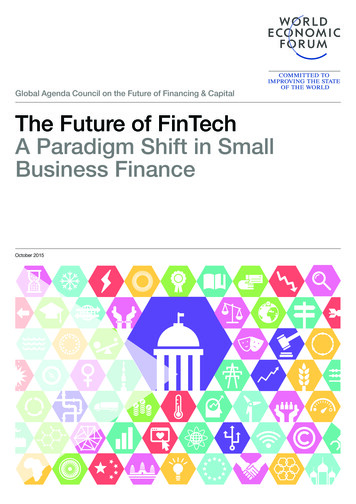
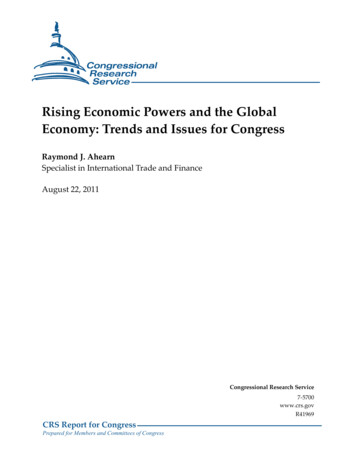
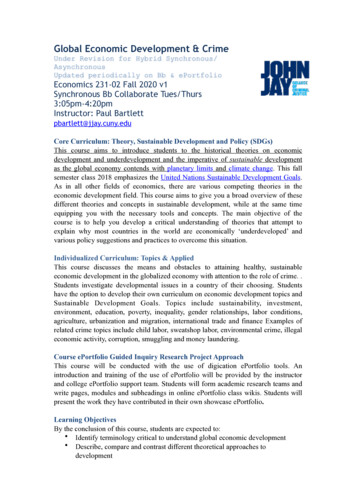



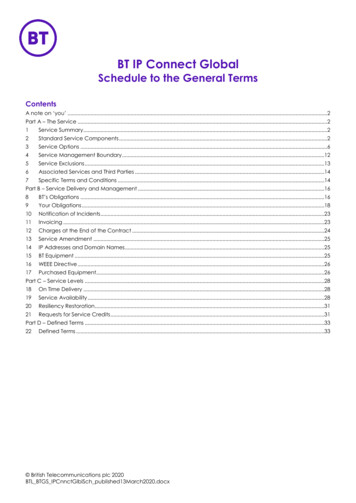
![[digital] Visual Effects and Compositing](/img/1/9780321984388.jpg)
